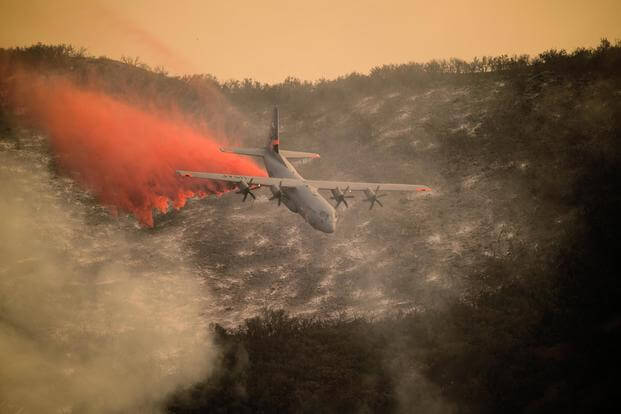The California National Guard has wrapped its response in support of civil authorities to contain the worst wildfires ever to hit the state.
Capt. William Martin of the California Military Department said that about 1,600-1,700 Guard personnel were activated at the height of the wildfires and were mostly withdrawn last week.
The response to the fires that broke out Dec. 4 included two C-130J aircraft from the 146th Airlift Wing of the Air National Guard, flying out of Channel Islands Air National Guard Station near Oxnard, California, Martin said.
The aircraft were equipped with Modular Airborne Fire Fighting Systems (MAFFS) to drop retardant on the blazes that were fanned by Santa Ana winds.
Two MQ-9 Reaper drones from the Air National Guard's 163rd Attack Wing, flying out of March Air Reserve Base near Moreno Valley, California, were used for surveillance and infrared detection of hot spots.
In addition, nine members of the New York Air National Guard's 174th Attack Wing were sent to California to assist the California Air National Guard's 163rd Attack Wing in flying the MQ-9 remotely piloted aircraft.
The Southern California wildfires centered in Ventura county burned an estimated 281,620 acres -- more than 440 square miles -- and destroyed more than 1,000 structures.
The wildfires have been associated with two deaths, including a firefighter. The fire's cause remains under investigation.
As of Tuesday, CalFire, the statewide firefighting agency, reported that the fires had been 88 percent contained.
"Businesses are open and eager to serve the public," CalFire said in a statement. "No forward progress of the fire is expected at this point."
"This has been an especially busy year, even by California standards" for the California Guard, Martin said.
In February, Guard personnel were activated for the response to the floods and threatened break of the Oroville dam in northern California and were also activated for wildfires in the summer and fall, Martin said.
The California wildfires capped an especially busy year overall for the military in responding to wildfires, three major hurricanes and other natural disasters that caused total damages estimated at more than $200 billion.
At one point, the commitments of heavy lift military aircraft to the Caribbean led to a brief delay in the deployments of additional troops to Afghanistan under President Donald Trump's new strategy to accelerate the war against the Taliban, an ISIS offshoot and Al Qaeda, Pentagon officials said.
In total, about 67,000 active duty and Guard personnel assisted civil authorities in response to the range of natural disasters this year, Lt. Col. Jamie Davis, a Pentagon spokesman, told CNBC.
Congress has been considering an $81 billion disaster aid package, nearly double the $44 billion initially requested by the White House, but Gov. Pedro Rossello of Puerto Rico has estimated that the island alone would need about $90 billion to recover from Hurricanes Irma and Maria.
If the $81 billion were to be approved, it would bring to $130 billion the amount Congress has spent this year on a particularly destructive season of hurricanes that tore through Florida, Louisiana, Texas, Puerto Rico and the Virgin Islands and wildfires that are still burning in California.
-- Richard Sisk can be reached at Richard.Sisk@Military.com.









